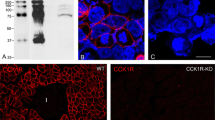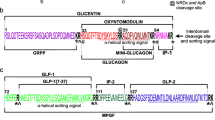Abstract
The enterochromaffin-like (ECL) cells of the gastric mucosa in animals play an important role in gastric acid secretion. They contain few granules and numerous secretory vesicles and microvesicles. They operate under the control of circulating gastrin. In the present study, we conducted an immunoelectron microscopic study for histamine (HA) in the ECL cells of rats given the proton pump inhibitor lansoprazole (LP), which is known to induce hypergastrinemia. The pre-embedding indirect immunoperoxidase procedure utilized a mouse monoclonal antibody AHA-2 against glutaraldehyde-conjugated HA. Rats received LP (50 μg/kg per day, subcutaneously) over a period of a month, and developed hypertrophy of the ECL cells in the stomach. It was clearly demonstrated that HA was located to a much higher degree in the cytoplasm of ECL cells of LP-treated rats than in normal rats. HA immunoreactivity was observed in the cores of the granules and secretory vesicles of the ECL cells in all the rats, but in the LP-treated rats it was observed in the cores of the newly developed vacuoles as well. These results may suggest that HA may be actively generated in the cytoplasm of the hypertrophic ECL cells of LP-treated rats. Also suggested in the present study is that HA is instrumental in the transformation of granules into secretory vesicles and in their consequent enlargement, and that vacuoles are formed by the fusion of large secretory vesicles. Furthermore, the finding that relatively little HA immunoreactivity existed in the vacuoles may suggest that the vacuoles actively degrade superfluous secretory products (for example, HA) through enhanced autophagocytosis and/or oxidative stress. Another possibility may be that the membrane-bounded structure regarded as the vacuoles in this study might actually be an invagination structure produced as a result of successive series of exocytosis through which the secretory vesicles actively and rapidly release HA.


Similar content being viewed by others
References
Andersson K, Mattsson H, Larsson H (1990) The role of gastric mucosal histamine in acid secretion and experimentally induced lesion in the rat. Digestion 46:1–9
Andersson K, Chen D, Håkanson R, Mattsson H, Sundler F (1992) Enterochromaffin-like cells in the rat stomach: effect of α-fluoromethylhistidine-evoked histamine depletion. A chemical, histochemical and electron-microscopic study. Cell Tissue Res 270:7–13
Andersson K, Zhao C-M, Chen D, Sundler F, Håkanson R (1996) Effect of α-fluoromethylhistidine-evoked histamine depletion on ultrastructure of endocrine cells in acid-producing mucosa of stomach in mouse, rat and hamster. Cell Tissue Res 286:375–384
Bottcher G, Håkanson R, Nilsson G, Seensalu R, Sundler F (1989) Effects of long-term hypergastrinemia on the ultrastructure of enterochromaffin-like cells in the stomach of the rat, hamster and guinea-pig. Cell Tissue Res 256:247–257
Chen D, Håkanson R, Sundler F (1993) Effect of omeprazole-evoked hypergastrinemia on ultrastructure of enterochromaffin-like cells in the stomach of portocaval-shunted rats. Cell Tissue Res 272:71–77
Chen D, Zhao C-M, Andersson K, Sundler F, Håkanson R (1996a) Ultrastructure of enterochromaffin-like cells in rat stomach: effect of α-fluoromethylhistidine-evoked histamine depletion and hypergastremia. Cell Tissue Res 283:469–478
Chen D, Zhao C-M, Nylander A-G, Håkanson R (1996b) Time course of hypertrophic and ultrastructural responses of rat stomach enterochromaffin-like cells to sustained hypergastremia. Cell Tissue Res 284:55–63
Chen D, Zhao C-M, Lindstrom E, Håkanson R (1999) Rat stomach ECL cells: up-date of biology and physiology. Gen Pharmacol 32:413–422
Creutzfeldt W (1988) The achlorhydria-carcinoid sequence: role of gastrin. Digestion 39:61–79
Fujiwara K, Kitagawa T, Inoue Y, Alonso G (1997) Monoclonal antibodies against glutaraldehyde-conjugated histamine: application to immunocytochemistry. Histochem Cell Biol 107:39–45
Fujiwara K, Bai G, Tamura C, Tsuru D (1999) Immunocytochemical localization of histamine in enterochromaffin-like cells (ECL cells) in rat oxyntic mucosa: a transmission electron microscopy study using monoclonal antibodies and conventional glutaraldehyde-based fixation. J Histochem Cytochem 47:1031–1038
Fujiwara K, Karasuyama M, Murata I, Tanabe M, Inoue Y, Tsuru D (2001) Immunoelectron-microscopic demonstration of histamine depletion in the gastric enterochromaffin-like cells of rats treated with α-fluoromethylhistidine. Cell Tissue Res 306:295–300
Graham RC, Karnovsky MJ (1966) The early stages of absorption of injected horseradish peroxidase in the proximal tubules of mouse kidney. Ultrastructural cytochemistry by a new technique. J Histochem Cytochem 4:291–302
Håkanson R, Sundler F (1991) Do histamine-storing cells in the gastric mucosa mediate the acid-stimulating action of gastrin? In: Uvnas B (ed) Histamine and histamine antagonists. Handbook Exp Pharm 97:325–346
Håkanson R, Owman C, Sporrong B, Sundler F (1971) Electron microscopic identification of the histamine-storing argyrophil (enterochromaffin-like) cells in the rat stomach. Z Zellforsch 122:460–466
Håkanson R, Larsson L-I, Liedberg G, Oscarson J, Sundler R (1976) The histamine-storing enterochromaffin-like cells of the rat stomach. In: Coupland RE, Fujita T (eds) Chromaffin, enterochromaffin and related cells. Elsevier, Amsterdam, pp 243–253
Håkanson R, Bottcher G, Ekblad E, Panula P, Simonsson M, Dohlsten M, Hallberg T, Sundler F (1986a) Histamine in endocrine cells in the stomach: a survey of several species using a panel of histamine antibodies. Histochemistry 86:5–77
Håkanson R, Bottcher G, Sundler F, Vallgren S (1986b) Activation and hyperplasia of gastrin and enterochromaffin-like cells in the stomach. Digestion 35:23–41
Håkanson R, Tielemans Y, Chen D, Andersson K, Mattsson H, Sundler F (1993) Time-dependent changes in enterochromaffin-like cell kinetics in stomach of hypergastrinemic rats. Gastroenterology 105:15–21
Håkanson R, Chen D, Andersson K, Monstein H-J, Zhao C-M, Ryberg B, Sundler F, Mattsson H (1994a) The biology and physiology of the ECL cell. Yale J Biol Med 67:123–134
Håkanson R, Chen D, Sundler F (1994b) The ECL cells. In: Johnson LR (ed) Physiology of the gastrointestinal tract, 3rd edn. Raven Press, New York, pp 1171–1184
Kahlson G, Rosengren E, Svensson SE (1973) Histamine and gastric acid secretion with special reference to the rat. In: Holton P (ed) Pharmacology of gastrointestinal motility and secretion, vol I. Pergmamon, Oxford, pp 41–101
Kollonitsch J, Perkins LM, Patchett AA, Doldouras GA, Marburg S, Duggan DE, Maycock AL, Aster SD (1978) Selective inhibitors of biosynthesis of aminergic neurotransmitters. Nature 274:906–908
Konagaya T, Bernsand M, Norlen P, Håkanson R (2001) Mobilization of rat stomach ECL-cell histamine in response to short- or long-term treatment with omeprazole and/or YF 476 studied by gastric submucosal microdialysis in conscious rats. Br J Pharmacol 133:37–42
Kubota H, Taguchi Y, Tohyama M, Matuura N, Shiosaka S, Ishihara T, Watanabe T, Shiotani Y, Wada H (1984) Electron microscopic identification of histidine decarboxylase-containing endocrine cells of the rat gastric mucosa. Gastroenterology 87:496–502
Lamberts R, Creutzfeldt W, Struber HG, Brunner G, Solcia E (1993) Long-term omeprazole therapy in peptic ulcer disease: gastrin, endocrine cell growth, and gastritis. Gastroenterology 104:1356–1370
Larsson H, Carlsson E, Mattsson H, Lundell L, Sundler F, Sundell G, Wallmark B, Watanabe T, Håkanson R (1986) Plasma gastrin and gastric enterochromaffin-like cell activation and proliferation. Studies with omeprazole and ranitidine in intact and antrectomized rats. Gastroenterology 90:391–399
Larsson H, Carlsson E, Håkanson R, Mattsson H, Nilsson G, Seensalu R, Obrink KJ (1991) Histamine and the parietal cells. In: Uvnas B (ed) Histamine and histamine antagonists. Handbook Exp Pharm 97:305–324
Lee H, Håkanson R, Karlsson A, Mattsson H, Sundler F (1992) Lansoprazole and omeprazole have similar effects on plasma gastrin levels, enterochromaffin-like cells, gastrin cells and somatostatin cells in the rat stomach. Digestion 51:125–132
Maton PN, Lack EE, Collen MJ, Cornelius MJ, David E, Gardner JD, Jensen RT (1990) The effect of Zollinger-Ellison syndrome and omeprazole therapy on gastric oxyntic endocrine cells. Gastroenterology 99:943–950
Obrink KJ (1991) Histamine and the parietal cells. In: Uvnas B (ed) Histamine and histamine antagonists. Handbook Exp Pharmacol 97:305–324
Peghini PL, Annibale B, Azzoni C, Milione M, Corleto VD, Gibril F, Venzon DJ, Fave GD, Bordi C, Jensen RT (2002) Effect of chronic hypergastrinemia on enterochromaffin-like cells: insight from patients with sporadic gastrinomas. Gastroenterology 123:68–85
Poynter D, Pick CR, Harcourt RA, Selway SA, Ainge D, Harman IW, Spurling NW, Fluck PA, Cook JL (1985) Association of long lasting insurmountable histamine H2 blockage and gastric carcinoid tumours in the rat. Gut 26:1284–1295
Ryberg B, Tielemans Y, Axelson J, Carlsson E, Håkanson R, Mattsson H, Sundler F, Willems G (1990) Gastrin stimulates the self replication rate of enterochromaffin-like cells in the rat stomach. Effects of omeprazole, ranitidine, and gastrin-17 in intact and antrectomized rats. Gastroenterology 99:935–942
Thomas-Reetz AC, De Camilli P (1994) A role for synaptic vesicles in non-neuronal cells: clues from pancreatic B-cells and from chromaffin cells. FASEB J 8:209–216
Thoring M, Hedenstrom H, Eriksson LS (1999) Rapid effect of lansoprazole on intragastric pH: a crossover comparison with omeprazole. Scand J Gastroenterol 34:341–345
Tielemans Y, Håkanson R, Sundler F, Willems G (1989) Proliferation of enterochromaffin like cells in omeprazole-treated hypergastrinemic rats. Gastroenterology 96:723–729
Tielemans Y, Axelson J, Sundler F, Håkanson R (1990) The serum gastrin concentration affects the self replication rate of the enterochromaffin-like cells in the rat stomach. Gut 31:274–278
Waldum HL, Sandvik AK, Brenna E, Petersen H (1991) Gastrin-histamine sequence in the regulation of gastric acid secretion. Gut 32:698–701
Wallmark B, Sundler F (1988) Time-course of development and reversal of gastric endocrine cell hyperplasia after inhibition of acid secretion. Studies with omeprazole and ranitidine in intact and antrectomized rats. Gastroenterology 95:1477–1486
Weibel ER (1969) Stereological principles for morphometry in electron microscopic cytology. Int Rev Cytol 26:235–302
Weibel ER, Bolender RP (1973) Stereological techniques for electron microscopic morphometry. In: Hayat MA (ed) Principles and techniques of electron microscopy. Biological applications, vol 3. Van Nostrand Reinhold, New York, pp 237–296
Zanner R, Gratzl M, Prinz C (2002) Circle of life of secretory vesicles in gastric enterochromaffin-like cells. Ann N Y Acad Sci 971:389–396
Zhao C-M, Jacobsson G, Chen D, Håkanson R, Meister B (1997) Exocytic proteins in enterochromaffin-like (ECL) cells of the rat stomach. Cell Tissue Res 290:539–551
Zhao C-M, Chen D, Kimura K, Håkanson R (1998) Reversibility of omeprazole-evoked changes in the ultrastructure of ECL cells in the rat stomach. Cell Tissue Res 291:91–95
Zhao C-M, Chen D, Lintunen M, Panula P, Håkanson R (1999a) Effects of reserpine on ECL-cell ultrastructure and histamine compartmentalization in the rat stomach. Cell Tissue Res 295:131–140
Zhao C-M, Chen D, Lintunen M, Panula P, Håkanson R (1999b) Secretory organelles in ECL cells of the rat stomach: an immunohistochemical and electron microscopy study. Cell Tissue Res 298:457–470
Zhao C-M, Bakke I, Tostrup-Skogaker N, Waldum HL, Håkanson R, Chen D (2001) Functionally impaired, hypertrophic ECL cells accumulate vacuoles and lipofuscin bodies. An ultrastructure study of ECL cells isolated from hypergastrinemic rats. Cell Tissue Res 303:415–422
Acknowledgements
We are grateful to Dr. Inoue of Nagasaki University for valuable suggestions throughout this study.
Author information
Authors and Affiliations
Corresponding author
Rights and permissions
About this article
Cite this article
Tanabe, T., Murata, I., Karasuyama, M. et al. Immunoelectron microscopic study for histamine in the gastric enterochromaffin-like cells of rats treated with the proton pump inhibitor lansoprazole. Histochem Cell Biol 120, 401–408 (2003). https://doi.org/10.1007/s00418-003-0583-7
Accepted:
Published:
Issue Date:
DOI: https://doi.org/10.1007/s00418-003-0583-7




